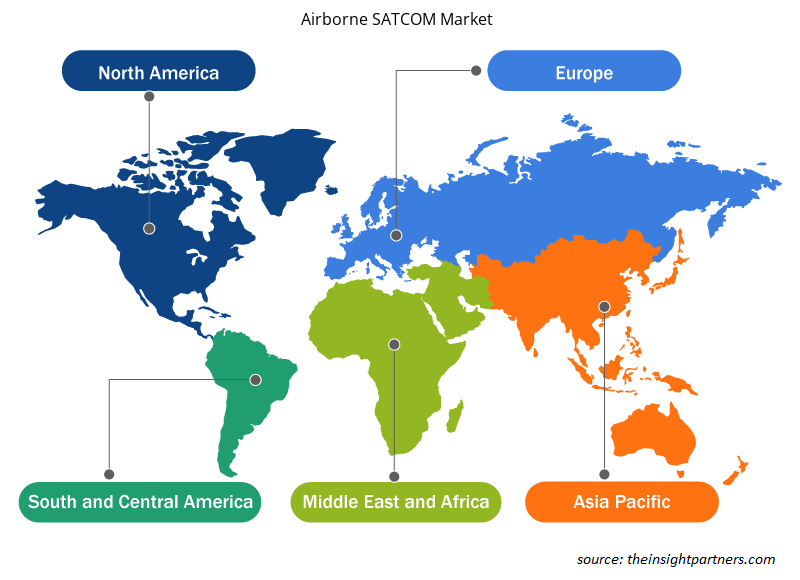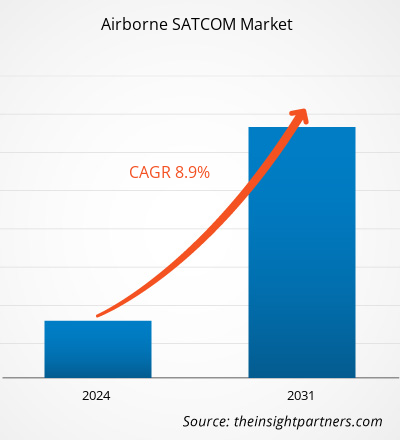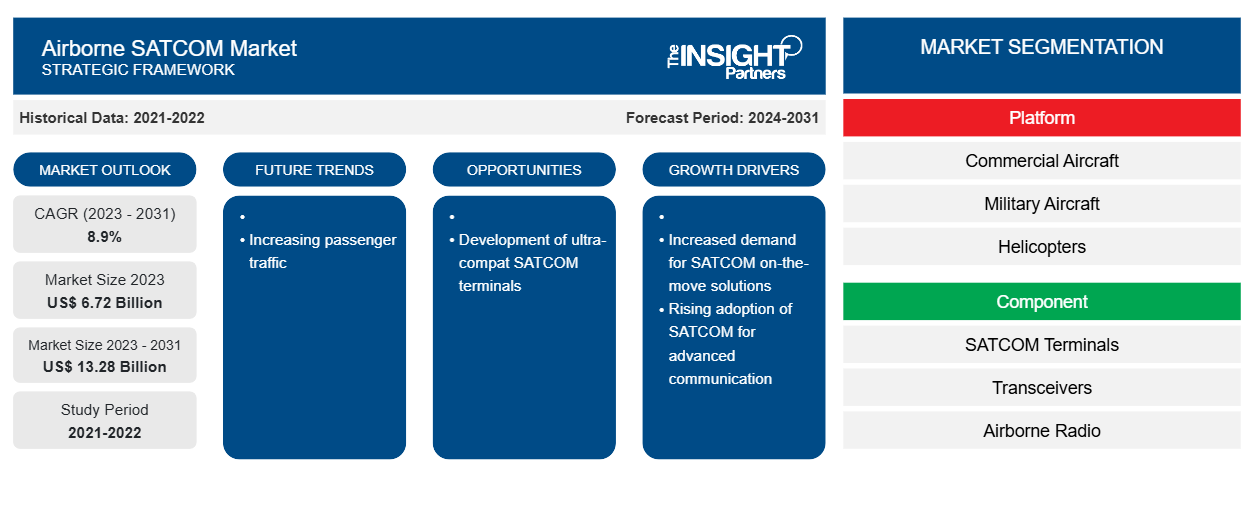공중 SATCOM 시장 규모는 2023년 67억 2,000만 달러에서 2031년 1,328억 달러로 증가할 것으로 예상됩니다. 이 시장은 2023~2031년 동안 8.9%의 CAGR을 기록할 것으로 예상됩니다. 항공 승객 교통량 증가는 시장의 주요 추세로 남을 가능성이 높습니다.
공중 SATCOM 시장 분석
공중 SATCOM 사업자로는 Collins Aerospace, Honeywell International Inc., General Dynamics Mission Systems, Inc., L3Harris Technologies, Inc., Viasat, Inc., Astronics Corporation 등이 있습니다. 공중 SATCOM 시장에는 글로벌 시장의 상당 부분을 차지하는 사업에 참여하는 많은 소규모 사업자가 있습니다. 소규모 사업자는 또한 향후 몇 년 동안 시장 규모를 더욱 강화하는 새로운 기술을 개발하기 위한 R&D 활동에 참여합니다. 이러한 조직은 수년에 걸쳐 정부 규제 기관의 도움을 받아 증가하는 고객 요구에 따라 새롭고 진보된 공중 SATCOM 개발에 대한 투자를 늘렸습니다. 정부 규제 기관은 방위, 공항 및 정부 기관에 계약을 제공함으로써 공중 SATCOM 제조업체를 돕습니다.
공중 SATCOM 시장 개요
글로벌 공중 SATCOM 시장 생태계의 주요 이해 관계자로는 원자재/구성 요소 공급업체, 공중 SATCOM 제조업체, 정부 규제 기관 및 최종 사용자가 있습니다. 원자재/구성 요소 공급업체는 공중 SATCOM 시장 생태계에서 중요한 이해 관계자입니다. SATCOM에 사용되는 주요 원자재로는 송신기, 수신기, 송수신기, 안테나, 공중 라디오, 모뎀 및 라우터, 고전력 증폭기 , 배터리 및 기타 장비가 있습니다. 이러한 모든 구성 요소의 적시 공급은 공중 SATCOM 제조 공장에서 효율적인 운영에 필수적입니다. 따라서 이러한 구성 요소 공급업체에 대한 모든 운영 영향은 공중 SATCOM 시장에 직접적인 영향을 미칩니다.
귀하의 요구 사항에 맞게 이 보고서를 사용자 정의하세요
이 보고서의 일부 또는 국가 수준 분석, Excel 데이터 팩을 포함하여 모든 보고서에 대한 사용자 정의를 무료로 받을 수 있으며 신생 기업 및 대학을 위한 훌륭한 혜택과 할인 혜택을 이용할 수 있습니다.
-
이 보고서의 주요 시장 동향을 알아보세요.이 무료 샘플에는 시장 동향부터 추정 및 예측까지 다양한 데이터 분석이 포함됩니다.
공중 SATCOM 시장 동인 및 기회
SATCOM On-The-Move(OTM) 솔루션에 대한 수요 증가
위성 통신 기술의 가장 중요한 응용 분야 중 하나는 이동 중 통신(COTM)으로, 다양한 기업에 중요한 서비스를 제공합니다. COTM은 군 및 상업 최종 사용자에게 응급 대응자, 재해 복구, 비상 대비, 원격 액세스 및 기타 응용 분야에 중요한 응용 프로그램을 제공합니다. 또한, 항공기가 이동하는 동안 위성 네트워크와 통신을 설정하고 유지할 수 있는 위성 접시가 장착된 상업용, 정부용 및 무인 항공기(UAV)와 같은 이동 항공기를 COTM이라고 합니다. 위성 기반 이동 중 통신(COTM)에 대한 수요는 방위 및 상업용 항공 통신 시스템의 새로운 트렌드로 부상했습니다. COTM 기술은 원래 보안 및 방위 산업을 위해 설계된 저이득 안테나 솔루션이 있는 고출력 L-대역 위성의 도입으로 인해 상당히 더 효과적이 되었습니다. 2018년 11월, Get SAT은 이동 중 L-대역 공중 응용 분야를 위한 UltraBlade L-대역 안테나 출시를 발표했습니다. 상업용 및 군용 고객과 운영자는 더 빠른 속도와 경쟁력 있는 대역폭 가격을 원합니다. 다양한 플랫폼에서 새로운 안테나 유형이나 연결 구매 방식이 필요해지면서 통신사 네트워크가 제한되고 있으며, 이로 인해 고급 이동형 공중 SATCOM 솔루션이 개발되고 있습니다.
초소형 SATCOM 단말기 개발
전술적, 장거리 기능을 갖춘 UAV는 실시간 정보, 감시 및 정찰(ISR) 데이터를 수집하여 지상국으로 전송하는 데 사용됩니다. 신뢰할 수 있는 고성능 위성 통신은 BLOS(시야 밖) 활동에서 지속적인 광대역 연결을 보장합니다. 최근 몇 년 동안 작은 면적에 고성능 및 처리량 L-대역 SATCOM 단말기를 갖춘 소형 항공기(UAV)에 대한 수요가 크게 증가했습니다. 예를 들어, Intellian은 2021년 10월에 새로운 FB250 및 Fleet One L대역 단말기가 Inmarsat 유형 인증을 받았다고 발표했습니다. Intellian Fleet One 단말기는 최대 150kbps의 동시 전화 및 데이터 통신을 위한 작고 견고하며 저렴한 솔루션입니다. 또한 2022년 1월, 국제 모바일 위성 통신 분야의 시장 리더인 Inmarsat은 초지능 및 통신이 Inmarsat Global Xpress 네트워크에서 새로운 초소형 SATCOM 단말기를 사용할 수 있도록 허용했습니다. 이 새로운 초소형 단말기는 크기, 무게, 전력 및 더 높은 성능 표준에서 선두 주자로, 작전 현장에서 통신 기능을 구축하여 현장의 군인과 지휘 및 통제 간의 임무 수행에 중요한 통신을 용이하게 합니다.
공중 SATCOM 시장 보고서 세분화 분석
공중 SATCOM 시장 분석에 기여한 주요 세그먼트는 플랫폼, 구성 요소, 애플리케이션입니다.
- 플랫폼을 기준으로 공중 SATCOM 시장은 상업용 항공기, 군용 항공기, 헬리콥터 , UAV로 세분화됩니다. 상업용 항공기 부문은 2023년에 더 큰 시장 점유율을 차지했습니다.
- 구성 요소를 기준으로 공중 SATCOM 시장은 SATCOM 단말기, 트랜시버, 공중 라디오, 모뎀 및 라우터, SATCOM 레이돔 및 기타로 세분화됩니다. 트랜시버 세그먼트는 2023년에 더 큰 시장 점유율을 차지했습니다.
- 응용 프로그램을 기준으로 공중 SATCOM 시장은 방위 및 상업으로 세분화됩니다. 상업 부문은 2023년에 더 큰 시장 점유율을 차지했습니다.
지역별 공중 SATCOM 시장 점유율 분석
공중 SATCOM 시장 보고서의 지리적 범위는 주로 북미, 유럽, 아시아 태평양, 중동 및 아프리카, 남미의 5개 지역으로 나뉩니다.
아시아 태평양 지역은 2023년 시장을 장악했으며, 그 뒤를 북미와 유럽 지역이 따랐습니다. 나아가 아시아 태평양 지역은 향후 몇 년 동안 가장 높은 CAGR을 보일 가능성이 높습니다. 중국은 아시아 태평양 지역에서 가장 큰 국가 중 하나로, 전 세계적으로 인구가 가장 많고 세계에서 가장 큰 제조 허브 중 하나입니다. 중국에는 Boeing, Airbus, COMAC, Pratt & Whitney, Changhe Aircraft Industries Corporation, Chongqing Helicopter Investment Corporation, Harbin Aircraft Industry Group, Yuneec International, Shenyang Aircraft Corporation, AVIC Aircraft Corporation, Guizhou Aircraft Industry Corporation의 시설이 있습니다. 이 나라는 항공기, UAV, 헬리콥터 및 기타 항공기 부품의 제조 및 생산에서 상당한 성장을 보였으며, 잘 정립된 항공우주 제조 허브도 있습니다. 예를 들어, 2021년 말까지 COMAC은 전국에 중국산 항공기 약 66대를 인도했다고 발표했습니다. 또한 Airbus China는 같은 기간 동안 전국에 상업용 항공기 약 142대를 인도했다고 발표했습니다.
공중 SATCOM 시장 지역 통찰력
Insight Partners의 분석가들은 예측 기간 동안 공중 SATCOM 시장에 영향을 미치는 지역적 추세와 요인을 철저히 설명했습니다. 이 섹션에서는 북미, 유럽, 아시아 태평양, 중동 및 아프리카, 남미 및 중미 전역의 공중 SATCOM 시장 세그먼트와 지리에 대해서도 설명합니다.

- 공중 SATCOM 시장에 대한 지역별 데이터 얻기
공중 SATCOM 시장 보고서 범위
| 보고서 속성 | 세부 |
|---|---|
| 2023년 시장 규모 | 67억 2천만 달러 |
| 2031년까지 시장 규모 | 132억 8천만 달러 |
| 글로벌 CAGR (2023-2031) | 8.9% |
| 역사적 데이터 | 2021-2022 |
| 예측 기간 | 2024-2031 |
| 다루는 세그먼트 |
플랫폼별로
|
| 포함된 지역 및 국가 |
북아메리카
|
| 시장 선도 기업 및 주요 회사 프로필 |
|
시장 참여자 밀도: 비즈니스 역학에 미치는 영향 이해
공중 SATCOM 시장 시장은 소비자 선호도의 변화, 기술 발전, 제품의 이점에 대한 인식 증가와 같은 요인으로 인해 최종 사용자 수요가 증가함에 따라 빠르게 성장하고 있습니다. 수요가 증가함에 따라 기업은 제품을 확장하고, 소비자의 요구를 충족하기 위해 혁신하고, 새로운 트렌드를 활용하여 시장 성장을 더욱 촉진하고 있습니다.
시장 참여자 밀도는 특정 시장이나 산업 내에서 운영되는 회사나 기업의 분포를 말합니다. 주어진 시장 공간에 얼마나 많은 경쟁자(시장 참여자)가 존재하는지 그 규모나 전체 시장 가치에 비해 나타냅니다.
공중 SATCOM 시장에서 운영되는 주요 회사는 다음과 같습니다.
- 아셀산 A.
- 탈레스 그룹
- 콜린스 항공우주
- 코밤 리미티드
- 허니웰 인터내셔널 주식회사
면책 조항 : 위에 나열된 회사는 어떤 특별한 순서에 따라 순위가 매겨지지 않았습니다.

- 공중 위성 통신 시장 주요 주요 업체 개요를 알아보세요
공중 SATCOM 시장 뉴스 및 최근 개발
공중 SATCOM 시장은 1차 및 2차 조사 이후의 정성적, 정량적 데이터를 수집하여 평가합니다. 여기에는 중요한 기업 간행물, 협회 데이터 및 데이터베이스가 포함됩니다. 공중 SATCOM 시장의 몇 가지 개발 사항은 다음과 같습니다.
- Astronics Corporation(Nasdaq: ATRO)은 글로벌 항공우주, 방위 및 기타 미션 크리티컬 산업을 위한 첨단 기술의 선도적 공급업체로, 오늘 차세대 위성 통신(SATCOM) 연결 기술을 대표하는 Typhon T-400 시리즈 시스템을 출시했습니다. Typhon T-400 시리즈는 모든 GEO 기반 Ku 위성 네트워크에서 원활하게 작동하도록 설계되어 항공기에 SATCOM 연결을 장착하는 데 드는 높은 비용과 관련된 과제를 효과적으로 해결합니다. (출처: Astronics Corporation, 보도자료, 2024년 3월)
- 글로벌 커뮤니케이션 회사인 Viasat Inc.(NASDAQ: VSAT)는 오늘 아일랜드 공군(IAC)의 Airbus C295 MSA 항공기에 안전하고 유연한 광대역 Ku 및 Ka 대역 공중 기술을 통합했다고 발표했습니다. IAC는 아일랜드 공군의 군사 방공 및 유엔 평화 유지 활동 지원에 중점을 둔 아일랜드 방위군 부서입니다. Viasat과 Airbus는 C295 MSA 항공기에 Viasat의 유연한 듀얼 밴드 광대역 단말기인 GAT-5530을 통합하여 이 다목적 군용 공중 플랫폼에 향상된 기능을 제공하기 위해 협력했습니다. Airbus는 올해 초 아일랜드 방위군에 C295 MSA 항공기 2대를 인도했습니다. (출처: Viasat Inc., 보도자료, 2023년 12월)
공중 SATCOM 시장 보고서 범위 및 제공물
"공중 SATCOM 시장 규모 및 예측(2021-2031)" 보고서는 아래 영역을 포괄하는 시장에 대한 자세한 분석을 제공합니다.
- 범위에 포함된 모든 주요 시장 세그먼트에 대한 글로벌, 지역 및 국가 수준의 공중 SATCOM 시장 규모 및 예측
- 공중 SATCOM 시장 동향 및 드라이버, 제약 및 주요 기회와 같은 시장 역학
- 포터의 5가지 힘에 대한 자세한 분석
- 주요 시장 동향, 글로벌 및 지역 프레임워크, 주요 업체, 규정 및 최근 시장 개발 사항을 포괄하는 공중 SATCOM 시장 분석
- 시장 집중도, 히트맵 분석, 유명 업체 및 공중 SATCOM 시장의 최근 개발 사항을 포함하는 산업 환경 및 경쟁 분석
- 자세한 회사 프로필
- 과거 분석(2년), 기준 연도, CAGR을 포함한 예측(7년)
- PEST 및 SWOT 분석
- 시장 규모 가치/거래량 - 글로벌, 지역, 국가
- 산업 및 경쟁 환경
- Excel 데이터세트
최근 보고서
사용 후기
구매 이유
- 정보에 기반한 의사 결정
- 시장 역학 이해
- 경쟁 분석
- 고객 인사이트
- 시장 예측
- 위험 완화
- 전략 기획
- 투자 타당성 분석
- 신흥 시장 파악
- 마케팅 전략 강화
- 운영 효율성 향상
- 규제 동향에 발맞춰 대응























 무료 샘플 받기 - 공중 SATCOM 시장
무료 샘플 받기 - 공중 SATCOM 시장